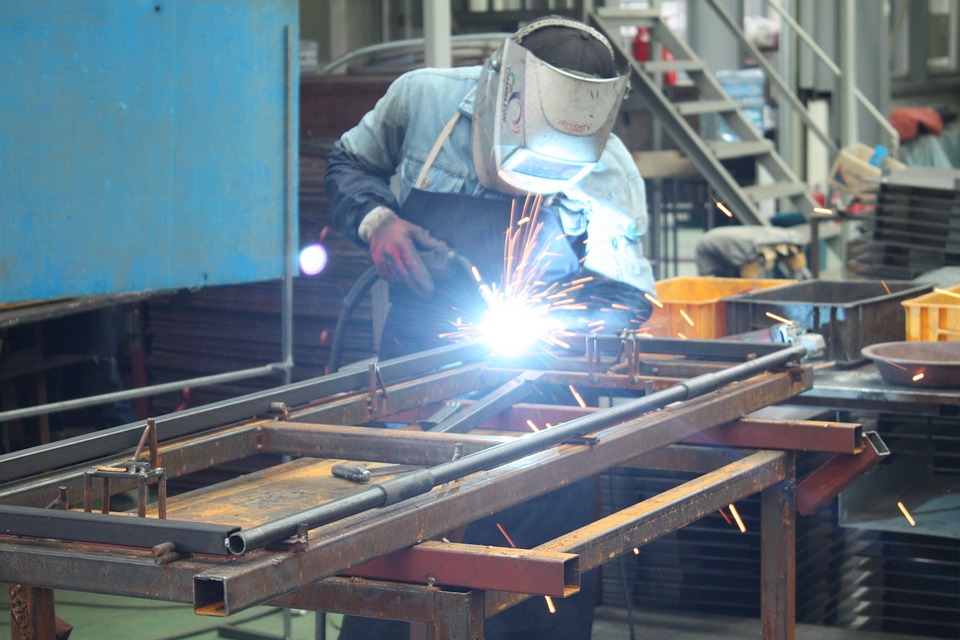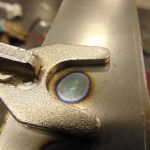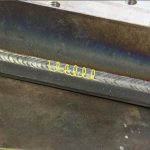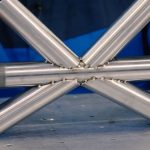If you’ve ever seen a welding torch, then this news may interest you.
With that being said, What is the brightness of the welding arc? Is it brighter or dimmer than the sun?
Well, the short answer to this question is “no”. Even though welding torch is made up of a lot of heat, which is emitted differently than the sun, it’s basically the same concept.
The sun’s rays consist of visible light, infrared, and ultraviolet wavelengths. One of the effects of ultraviolet light is sunburn.
When we look at the welding arc, we actually see rays of light, ultraviolet, infrared, and visible light. Light can either be emitted from the sun or from a torch.
When the torch is used, there are basically three kinds of light: visible light, infrared, and ultraviolet light.
These, along with other articles on our site, will point you in the right direction when starting your welding career.
How Bright is A Welding Arc Compared to the Sun?
Contents
To compare the brightness of the welding arc to the sun, we must measure the radiation emitted by the welding arc and the luminosity of the sun.
To find the ratio of the radiation emitted by the welding arc to the sun, we need to use irradiance, which measures how much radiation falls on the surface area of an object.
Burning
The welding arc’s temperature may reach up to 3400 degrees Fahrenheit.
The welding arc, if not managed properly, may melt the dummy and operator’s clothing and cause serious burns.
The operator needs to limit their exposure time and be aware of the arc temperature to protect the operator and nearby workers from burn injury.
Skin Cancer
According to the International Agency For research on Cancer, welders face a risk of skin cancer due to prolonged exposure to UV rays.
The depletion in ozone layer caused by increasing production of manmade chemicals has caused a rise in the amount of radiation received that causes skin cancer.
There are ways to protect skin from the effects of excessive exposure to UV radiation.
It is essential to use an SPF of 30 or higher for skin protection.
UVA and UVB rays are mutagenic and carcinogenic, which means they cause mutations and cancerous cells to form.
If a worker spends more than five minutes in a welding booth without wearing an adequate amount of protection, this increases their risk of getting skin cancer.
Welder Eye Or Arc Eye
Conjunctivitis, often known as welder’s Eye or Arc Eye, occurs when UV light causes the cornea of the eye to swell and become reddened.
The condition, also known as Corneal Iritis, has a myriad of causes, including exposure to UV rays, frequent use of welding goggles, and severe allergies.
The UVB and UVC rays generated inside the welding helmet and reflected on the metal being welded can damage the cornea.
UV radiation has even been linked to cataracts and macular degeneration. When a welder has arc eye, he is at a high risk of developing welder’s lung.
The sensation of’sand in the eye’ can be felt around the entire eyeball, and over time, the cornea can break down, exposing the fovea, or central area of the cornea, to the sun, which can create an eye condition known as corneal sunburn.
However, with continuous exposure to the radiations, symptoms such as redness , bleeding, and mild to severe discomfort can occur.
Welding Arcs and UV Rays
The wavelength of ultraviolet radiation generally corresponds to a color in the visible light spectrum.
Welding arcs, as we all knew, emit UV rays.
Both welding arcs and the sun’s rays emit photons in the UV range. UVA, UVB, and UVC are all forms of UV light.
UVA is the form of UV light that makes you wince in the sun and sand in your eyes. UVB and UVC are the more dangerous types of UV light that can produce DNA damage and even increase the risk of cancer when used over long periods of time.
Both welding arcs and the sun’s rays have four rays, or energy particles. Heat weld machines emit a concentrated beam of UV light, which penetrates a thin layer of material to create a weld pool.
Welders stand over the pool and spray it with argon gas, which separates the atoms in the iron and melts the weld pool.
Welders may have visual issues, blindness, cancer, and a host of health problems due to their frequent exposure to UV radiation.
UVA, UVB, and UVC rays are all classified as ultraviolet radiation, which can damage the chemistry of your eyes and result in cataracts and skin cancer.
All three forms of UV radiation are harmful to the eyes, skin, and even the DNA of human beings.
The majority of UV rays emitted by welding arcs are UVA harmful rays.
Although UVB and UVC rays make the sun shine, they also cause sunburn and skin cancer.
The atmosphere blocks 95 percent of UVB and 100 percent of UVA radiation. This allows workers to weld under sunlight without consequences.
Atmosphere
Thanks to nature, we have an ozone layer that absorbs many of these harmful rays.
Only a tiny percentage of damaging UV b spectrum rays are able to penetrate beyond the atmosphere.
Radiation in ultraviolet (UV) and infrared (IR) light can be harmful to the skin and eyes. These rays can cause burning of the skin as well as sunburn.
The UVB spectrum is harmful because it rapidly ages and damages the skin’s DNA. Because of this, the ozone layer is depleted by too much UV exposure and so can throw off the balance of nature.
Welders, on the other hand, are exposed to the full gamut of UV rays.
Ultraviolet rays are a type of electromagnetic radiation. These rays make ultraviolet rays and infrared rays seem like part of the visible light spectrum.
Ultraviolet rays have a very short wavelength. They can cause skin cancer, cataracts, and photokeratitis (keratitis is inflammation of the superficial layers of the cornea).
Welders can become exposed to UV radiation by working outdoors for long periods.
Distance
Because the sun ‘s rays do not pass through glass, glass is a viable shield against dangerous radiation.
48 million kilometers away from the planet, the radiated energy from the sun isn’t any hotter than it is when hitting a welder’s helmet.
A welder, on the other hand, is able to handle a torch with less discomfort and damage.
As a result, it has a greater impact on an welder’s health and safety than it would on a person standing on the ground.
From a closer distance, high-energy photons impact the eyes, rather than the skin.
The discomfort and damage one experiences from welding arc radiation can be assessed by looking at two types of symptoms: thermal burns of the eyes, and skin burns.
Thermal burns, which are most often caused by welding, can permanently damage the cornea, retina, and lens of the eye.
Skin burns, which can also result from welding, can be extremely painful and may require medical intervention.
Luminosity and Intensity
At a distance of half a meter or 122 inches, the intensity of a welding arc is about 250 watts per square meter, which is 250,000 watts. A welding arc is many times brighter than the sun.
At 1 meter, the intensity level is roughly half that at 2 meters.
During the summer months, however, the arc’s intensity is greater than that of the sun at noon.
As a result, the solar intensity at noon in sunny regions is hazardous to human health.
As can be seen from these comparisons, a welding arc can be quite intense.
Heat
The sun’s temperature is 5800K, which is much higher than the arc temperature.
However, we are unable to maintain such high temperatures on earth because the atmosphere is too thin.
Welding arcs have a temperature about 100°C hotter than the sun’s surface temperature.
The welding arc is held at an extremely high temperature so that it melts the metal.
The temperature of the sun, on the other hand, is even greater than that of the average welding arc.
The emitted heat from the sun radiates outward 6,000 feet. The arc produced extends about 12 feet.
Of course, the sun’s radiated heat is larger than the arc’s.
How Bright Is The Sun?
As I already said, no other light source compares to the brilliance of the sun.
It is the region of the solar system where the vast majority of the world’s visible and infrared light comes from.
When it comes to direct sunlight, the amount of radiant flux it produces is 93% more than the amount of light emitted by the sun.
It is the principal source of illumination for most of the Earth’s surface.
Direct sunshine, on the other hand, has two main wavelengths: the visible and ultraviolet. This light, when directly exposed to the skin, can trigger various types of skin cancer.
The statistics are 93 lumens per watt at an illuminance of 98000, or 97 lumens per watt at an illuminance of 99000, depending on the region where it is measured.
The small difference in lumen count can be explained by wavelength, as greater numbers of shorter wavelengths are reflected by the atmosphere.
The visible light spectrum accounts for only five percent of the energy emitted by the sun.
These numbers indicate that at sea level, a 10 m2 area would receive 52096 watts of illumination.
It is true that the solar spectrum contains a wide range of colors, but the main colors are yellow, orange, and red.
While yellow light is perceived negatively by human eyes, when it comes to photosynthesis, it is a positive sign. Red light is essential for the germination of plants.
In addition to this, some animals, such as crustaceans and insects, are able to see ultraviolet light. Humans, on the other hand, cannot see it.
Also Read: Is welding hard?
How Bright Is A Welding Arc?
The welding arc is bright and incredibly hot.
It’s so hot that the welding arc can reach temperatures as high as 10000 kelvins, or 150000 degrees Fahrenheit.
These high temperatures cause the skin to blister and burn at the surface of the welder’s body. The amount of heat generated depends on the length of the weld and the temperature ratio.
A high temperature leads to a fusion between the parts. And after welding, one that doesn’t cause injury to the welder.
Welders cannot cope with the arc of welding without installing and using a welding helmet.
Allow me to state unequivocally that welding arcs are the most powerful sources of heat known to humankind.
It can’t compete with the intensity being emitted by a welding arc! Welding arc itself itself is not the subject of study.
The heat produced by a welding arc may reach 5000 kelvins (or 800 °F).
Now there is an obvious distinction between the brightness of the sun and that of a welding arc.
The welders are aware of that fact. Therefore, in order to focus their attention on the task at hand, they shield their eyes with welding helmets.
Conclusion
So, to summarize the preceding arguments, weld arcs are less bright than the sun, but they are still harmful to humans.
However, bear in mind that welding arc brightness contains too much ultraviolet radiation.
When standing adjacent to a welding arc, you are exposed to these harmful rays, which can lead to skin cancer.
Between the sun and Earth, there is a protective ozone layer. If our protective ozone layer is damaged by pollution, it can let harmful ultraviolet radiation pass through, allowing UV rays to enter our atmosphere.





